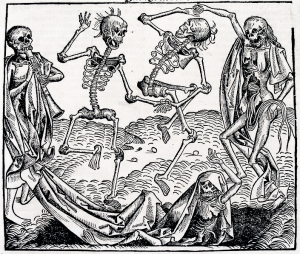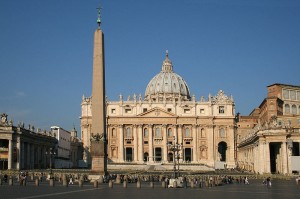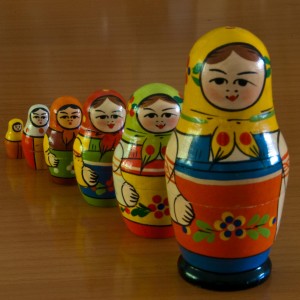Black Death: the Black Death was an unbelievably devastating disease that killed almost 20 million people in Europe between 1348-50 CE. This disease entered Europe in 1347 “when 12 Genoese trading ships docked at the Sicilian port of Messina after a long journey through the Black Sea” (History.com). Robert Langdon notices a carving of a “three-headed, man-eating Satan”(p.82, Brown) on the seal of this bio-tube, which brings him back to his previous visions of the “three-headed, horned Satan who was in the process of eating three different men at once” (p.83, Brown). Both the vision and the carving are known to be “icons associated with the Black Death” (p.84, Brown), but also they might represent a monster that Dante created in hisversion of the inferno; Dante explains this Satan is “ugly” and “on his one head, he has three faces” and “two wings spread out…they had no feathers, but were fashioned like a bat’s” (Canto XXXIV, Alighieri). An interesting fact is that Dante wrote his Inferno before the Black Death occurred, so the Dan Brown’s reference might refer to Dante’s Inferno or the history of the Black Death in society. The idea of the Black Death comes up continually throughout the novel until Professor Langdon finally realizes what he was brought to Italy to do. (http://en.wikipedia.org/wiki/Dante%27s_Satan) (http://en.wikipedia.org/wiki/Black_Death) (http://www.history.com/topics/black-death) (http://en.wikipedia.org/wiki/File:Holbein-death.png) (http://en.wikipedia.org/wiki/File:Holbein-death.png)
the Black Death was an unbelievably devastating disease that killed almost 20 million people in Europe between 1348-50 CE. This disease entered Europe in 1347 “when 12 Genoese trading ships docked at the Sicilian port of Messina after a long journey through the Black Sea” (History.com). Robert Langdon notices a carving of a “three-headed, man-eating Satan”(p.82, Brown) on the seal of this bio-tube, which brings him back to his previous visions of the “three-headed, horned Satan who was in the process of eating three different men at once” (p.83, Brown). Both the vision and the carving are known to be “icons associated with the Black Death” (p.84, Brown), but also they might represent a monster that Dante created in hisversion of the inferno; Dante explains this Satan is “ugly” and “on his one head, he has three faces” and “two wings spread out…they had no feathers, but were fashioned like a bat’s” (Canto XXXIV, Alighieri). An interesting fact is that Dante wrote his Inferno before the Black Death occurred, so the Dan Brown’s reference might refer to Dante’s Inferno or the history of the Black Death in society. The idea of the Black Death comes up continually throughout the novel until Professor Langdon finally realizes what he was brought to Italy to do. (http://en.wikipedia.org/wiki/Dante%27s_Satan) (http://en.wikipedia.org/wiki/Black_Death) (http://www.history.com/topics/black-death) (http://en.wikipedia.org/wiki/File:Holbein-death.png) (http://en.wikipedia.org/wiki/File:Holbein-death.png)
Saligia: Professor Robert Langdon and Sienna Brooks recognize the word ‘Saligia’ carved on the outside of the bio-tube. Saligia is a “Latin mnemonic invented by the Vatican in the Middle Ages to remind Christians of the Seven Deadly sins” (Wikipedia). “The Catholic church divides the sin into two categories: venial sins …and mortal sins” the different between these two categories is whether or not one can be forgiven for the sin or not–how serious the sin actually is (Prineton.edu). Sienna Brooks explains that the mnemonic stands for “pride, greed, lust, envy, gluttony, wrath, and sloth” (p.83, Brown). Truthfully these sins are not exactly the same as the original sins according to Christianity, but instead theywere slightly altered by Dante Alighieri in his Divine Comedy. After this conversation, Sienna and Professor Langdon are able to understand why this word is carved into the bio-tube seal. These sins are a direct reference to Dante’s Inferno, and cause professor Langdon to continue to see images associated with the Black Death. (http://en.wikipedia.org/wiki/Seven_deadly_sins) (http://www.princeton.edu/~achaney/tmve/wiki100k/docs/Seven_deadly_sins.html)
Vasari:  Giorgio Vasari was a famous artist in the late 1500s. He is an important painter in this story due to the fact that his paintings are in the Hall of 500 in the Palazzo Vecchio, an amazing renaissance building in the heart of Florence, Italy. At this point in the novel one does not officially know that Professor Langdon is saying the word Vasari, but instead he is continually, in a confused state, saying “very sorry…very sorry”. As one learns later on in the novel, due to the head injury that Robert Langdon experienced, he has forgotten all about why he comes to Italy and what he is supposed to accomplish while he is there. Eventually, Professor Langdon realizes that after seeing that painting via the bio-tube with the agitator ball, that Vasari is a clue as to where to go to find they next step. (http://en.wikipedia.org/wiki/Palazzo_Vecchio) (http://en.wikipedia.org/wiki/Giorgio_Vasari)
Giorgio Vasari was a famous artist in the late 1500s. He is an important painter in this story due to the fact that his paintings are in the Hall of 500 in the Palazzo Vecchio, an amazing renaissance building in the heart of Florence, Italy. At this point in the novel one does not officially know that Professor Langdon is saying the word Vasari, but instead he is continually, in a confused state, saying “very sorry…very sorry”. As one learns later on in the novel, due to the head injury that Robert Langdon experienced, he has forgotten all about why he comes to Italy and what he is supposed to accomplish while he is there. Eventually, Professor Langdon realizes that after seeing that painting via the bio-tube with the agitator ball, that Vasari is a clue as to where to go to find they next step. (http://en.wikipedia.org/wiki/Palazzo_Vecchio) (http://en.wikipedia.org/wiki/Giorgio_Vasari)

Sumerians: this phrase is used in the novel when Robert Langdon is explain the “outside cover” of the bio-tube that he as well as Sienna Brooks found in a hidden pocket in his jacket. The Sumerian people lived in Mesopotamia, modern day Iraq, during the early Bronze Age (3600-1200 BC). The Sumerian people are also often referred to as the “black-headed ones” and “Well before 3000 BC Sumerians were recording their language using simple pictures” (britishmuseum.org). The Sumerians are recognized in this part of the novel because they are credited with the first to use “cylinder tubes which were precursors to the intaglio form of printmaking”. This part of the novel is important because Robert and Sienna are worried that the contents of the bio-tube could be detrimental to society. This is also simply fascinating to Professor Langdon because he is a scholar of “religious iconology and symbology” (wikipedia), and therefore is interested by how old the carving looks and who created it.(http://en.wikipedia.org/wiki/Sumer) (http://www.britishmuseum.org/explore/cultures/middle_east/sumerians.aspx) (http://en.wikipedia.org/wiki/Robert_Langdon) (http://en.wikipedia.org/wiki/File:Trilingual_inscription_of_Xerxes,_Van,_1973.JPG)
Superbia: Superbia is the Latin word for Pride-one of the seven deadly sins. This reference comes when Robert Langdon is explaining to Sienna Brooks what ‘Saligia’ stands for on the outer covering of the bio-tube. This reference is important because it is the beginning of when Sienna and Robert begin to understand what they must do to deal with the impending danger upon society. Pride, in this sense, is meant to have a negative connotation and explain ones “inflated sense of one’s personal status” (wikipedia). The sin of Pride is referred to as the “original sin that generates every other and is the vital principle in each” (baylor.edu). (http://en.wikipedia.org/wiki/Pride)
Avaritia: Avaritia is the Latin word for Greed, “a sin of excess”-another one of the seven deadly sins. In Dante’s Inferno, those who are gluttonous are placed in the third level of hell and forced to lie on the ground as “sewage” (wikipedia) rains down upon them- “That downpour makes the sinners howl like dogs” (Canto VI, line 19). As Dante and Vergil continue down through hell, Dante is amazed about how different the punishments are for different sins, but Vergil then explains that the “perfection” or the punishment is meant to match how bad the sin was in the real world. (http://www.divinecomedy.org/divine_comedy.html) (http://www.sparknotes.com/poetry/inferno/section3.rhtml)
Luxuria: Luxuria is the Latin word Lust, usually a sin for those who cannot control their desires; people who want as much as possible in the material world are put in this category within the seven deadly sins. In Dante’s Inferno, those who are lustful are in the second circle of hell and have an everlasting storm of rain and wind around them to punish them for “their lack of self-control to their lustful passions in earthly life”. The idea of intense sexual desire is one way to view the sin of lust, but it also might be the “lust for power” (msdn.com) which is another type of person that might be in the second circle of hell-those who desire too much. (http://en.wikipedia.org/wiki/Dantes_Inferno) (http://en.wikipedia.org/wiki/Seven_Deadly_Sins#Lust) (http://blogs.msdn.com/b/deomel/archive/2007/02/06/luxuria-first-of-seven-deadly-sins.aspx)
Invidia: Invidia is the Latin word for Envy—“an insatiable desire”. In Dante’s Purgatory, the punishment for those who suffer from Envy “to have their eyes sewn shut with wire because they have gained sinful pleasure from seeing others brought low”. In Dante’s Inferno those who are envious are placed in the fourth circle of hell. (http://en.wikipedia.org/wiki/Envy) (http://danteworlds.laits.utexas.edu/circle4.html)
Gula: Gula is the Latin word for Gluttony, which is usually known as the excess of food or drink, but it can also be viewed as “selfishness”. In Dante’s Inferno those who are gluttonous are also placed in the third circle of hell withthose are who greedy. These people are placed without vision in this area and are unable to communicate with others to show how selfish and cold they were in the earthly world. (http://en.wikipedia.org/wiki/Dantes_Inferno) (http://en.wikipedia.org/wiki/Seven_deadly_sins#Gluttony)
Ira: Ira is the Latin word for anger, yet another one of the deadly sins and a punishable offense in Dante’s Inferno in the fifth circle of hell. Those who were full of wrath in the real world must fight one another in the water and others must simply stay within the river for eternity. Suicide was considered “the ultimate, albeit tragic, expression of hatred directed towards inwardly a final rejection of God’s gifts”. (http://en.wikipedia.org/wiki/Wrath) (http://en.wikipedia.org/wiki/Dantes_Inferno)
Acedia: Acedia is the Latin word meaning Sloth-another one of the deadly sins. Often this is categorized as laziness and Dante explained it as “the failure to love god with all one’s heart, all one’s mind, and all one’s soul”. (http://en.wikipedia.org/wiki/Saligia) (http://en.wikipedia.org/wiki/Acedia)
Vatican: The Vatican is the “Holy See” of the “episcopal jurisdiction of the Roman Catholic Church in Rome” (Wikipedia). In the novel Robert Langdon explains that the mnemonic ‘Saligia’ was created by the Vatican in the Middle Ages. The Vatican, the head of the Catholic Church, believed that the deadly sins were gluttony, fornication, greed, pride, sorrow, wrath, vainglory, and sloth; th ese sins are categorized into three different groups: lustful appetite, irascibility, and acedia. It is evident that these are very similar to the deadly sins that Dante explains in his Inferno. (http://en.wikipedia.org/wiki/Holy_See) (http://en.wikipedia.org/wiki/Seven_deadly_sins) (http://fr.wikipedia.org/wiki/Obélisque_du_Vatican)
ese sins are categorized into three different groups: lustful appetite, irascibility, and acedia. It is evident that these are very similar to the deadly sins that Dante explains in his Inferno. (http://en.wikipedia.org/wiki/Holy_See) (http://en.wikipedia.org/wiki/Seven_deadly_sins) (http://fr.wikipedia.org/wiki/Obélisque_du_Vatican)
Intaglio: Intaglio is a type of printmaking invented by the Germans in 1400s. Professor Langdon believes that the seal around the bio-tube was a type of “precursor to the intaglio form of printmaking” (p.144). This process includes placing a plate under the ground and then using a needle to carve the image into the ground, and then the plate is dipped into acid, which then reveals the image upon the plate. Professor Langdon and Sienna are very interested in this type of image because at this point in the novel they are trying to figure out what is inside of the bio-tube and whether it is dangerous or not, and whether it is old or new. (http://en.wikipedia.org/wiki/Intaglio_(printmaking))
Russian Nesting Doll:  These dolls are also called Matryoskha dolls—often made of wood that are smaller than the preceding doll and find inside on another. They were originally carved in 1890. The outside doll is usually dressed in a traditional Russian dress, and the last doll is usually a baby made of only one piece of wood. These dolls are often used as metaphors, as they are in this novel, for knowing that there is more than what is original on the surface. (http://en.wikipedia.org/wiki/Russian_Nesting_Dolls)
These dolls are also called Matryoskha dolls—often made of wood that are smaller than the preceding doll and find inside on another. They were originally carved in 1890. The outside doll is usually dressed in a traditional Russian dress, and the last doll is usually a baby made of only one piece of wood. These dolls are often used as metaphors, as they are in this novel, for knowing that there is more than what is original on the surface. (http://en.wikipedia.org/wiki/Russian_Nesting_Dolls)
Life Savers: Life Savers are an American fruit flavored candy that is named after the shape of lifebuoys. (http://www.flickr.com/photos/avantreese/2528343701/) (http://en.wikipedia.org/wiki/Life_Savers)
Sophie Robart: srobart@middlebury.edu
